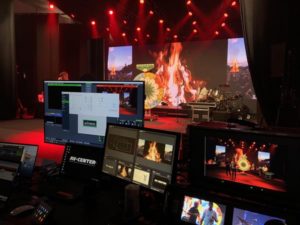
The Importance Of Stage Lighting For Events
 While stage lighting originally started as a way to make sure the audience could see the actors it has evolved to a craft. It requires the desiner to work with electricians, directors, choreographers and requires an open mind. If you are having a corporate event lighting is also important to get really great event photography. If your stage is not lit well then the pictures will not turn out right.
While stage lighting originally started as a way to make sure the audience could see the actors it has evolved to a craft. It requires the desiner to work with electricians, directors, choreographers and requires an open mind. If you are having a corporate event lighting is also important to get really great event photography. If your stage is not lit well then the pictures will not turn out right.
Lighting is more than just lighting a space “Lighting creates mood and an emotionally responsive space. Lighting can create architecture and it can manipulate our sense of space,” Taylor says. “It also has a deep connection to music and rhythm and, especially, an audience's experience of time … Those are things that define the human experience and lighting gets involved in all of those questions.” Taylor's work on the production of “ Four Quartets ” underscores the simplicity and emotion stage lighting design can evoke. The piece includes a reading by Kathleen Chalfant of T.S. Eliot's four poems of the same name, choreography by Pam Tanowitz, music by composer Kaija Saariaho and paintings by American artist Brice Marden. Taylor designed the scenery and lighting. (uncsa.edu)
Lighting can:
- Ensure visibility
- Set the mood on stage.
- Portray emotions.
- Draw the performers into the foreground.
- Offer emphasis where needed.
When you actually have a audio visual technician or lighting designer take the time to create a stage wash that fits your event but also the emotion you are trying to convey you no longer are just having an event you are creating an experience. Lighting works with other elements such as your stage design, video graphics, and your speakers or performers to elevate it into a memorable experience.
Lighting changes with your needs.
A good lighting designer will focus on five main positions for stage lighting and place different types of lighting fixtures in these locations depending on your needs and your messaging. Listed below is the main locations that a designer will place lights to create what is known as a "stage wash".
Front Lights
– These lights are the primary source of lighting for the event.
Side Lighting
– Primarily used to highlight the sides of the performer’s body.
High Side Lighting
– These shine the light on the top of the performer’s head, neck and shoulders so you can see their facial expressions.
Back Lighting
– These lights create depth and separate the performer with the background.
Down Lights
– This lighting is used to wash an area of the stage with soft or harsh light.
Different Types Of Lighting Fixtures Used In Stage Lighting
Automated Lighting
Automated lighting or referred to as intelligent lighting can be a flexible and economical alternative to stationary lighting. It’s perfect for events in a theater, nightclub, concert hall or church. These lights often have the ability to change color and shapes to create a variety of different looks.
Conventional Fixtures and Spotlights
Unlike automated lighting, conventional lighting fixtures provide only one function, and that's illumination. While technology has come a long way and LED lighting allows conventional fixtures to also change color these lights are often static and do not move. These lights are most often used for front lighting and down lighting. We recommend conventional lighting for conferences, company events or large seminars where there’s only one person speaking at a time.
LED Lighting
LED lighting is the most energy-efficient way of lighting an event. The often have the ability to change color with a lighting console and produce very little heat. There are LED versions of traditonal conventional fixtures. The LED lighting use has an added benefit that the on-stage performers appreciate the comfort of LEDs, as they emit very little heat and they rarely need replacing.
